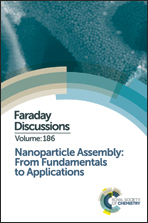Membrane-mediated aggregation of anisotropically curved nanoparticles†
Abstract
Using systematic numerical simulations, we study the self-assembly of elongated curved nanoparticles on lipid vesicles. Our simulations are based on molecular dynamics of a coarse-grained implicit-solvent model of self-assembled lipid membranes with a Langevin thermostat. Here we consider only the case wherein the nanoparticle–nanoparticle interaction is repulsive, only the concave surface of the nanoparticle interacts attractively with the lipid head groups and only the outer surface of the vesicle is exposed to the nanoparticles. Upon their adhesion on the vesicle, the curved nanoparticles generate local curvature on the membrane. The resulting nanoparticle-generated membrane curvature leads in turn to nanoparticle self-assembly into two main types of aggregates corresponding to chain aggregates at low adhesion strengths and aster aggregates at high adhesion strength. The chain-like aggregates are due to the fact that at low values of adhesion strength, the nanoparticles prefer to lie parallel to each other. As the adhesion strength is increased, a splay angle between the nanoparticles is induced with a magnitude that increases with increasing adhesion strength. The origin of the splay angles between the nanoparticles is shown to be saddle-like membrane deformations induced by a tilt of the lipids around the nanoparticles. This phenomenon of membrane mediated self-assembly of anisotropically curved nanoparticles is explored for systems with varying nanoparticle number densities, adhesion strength, and nanoparticle intrinsic curvature.
- This article is part of the themed collection: Nanoparticle Assembly: From Fundamentals to Applications

 Please wait while we load your content...
Please wait while we load your content...